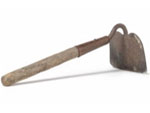At a Glance
Topics
Website
Features
Duration
Grade(s)
Lesson Format
Download
The Short-Handled Hoe
Students view a variety of documents and artifacts related to the short-handled hoe, migrant labor, and the United Farm Workers. They then draw on these sources to develop an online museum exhibit for the hoe.
Review

This lesson uses a simple farming tool, the short-handled hoe, to introduce students to migrant labor in California and the farm worker labor movement.
After a brief introduction to the hoe and the bracero program that brought workers to California from Mexico, students explore a variety of artifacts to understand the context of the hoe’s use, as well as the United Farm Workers’ role in the 20th-century labor and civil rights movement. Students then draw from these varied sources to create an online museum exhibit centered on the hoe.
One of the great strengths of this lesson is that it starts with what seems a simple artifact, the short-handled hoe, but leads students towards more complex thinking, including grappling with the artifact’s larger symbolic and political meanings and its historical significance. The lesson also provides an excellent opportunity for teaching about historical context because placing the short-handled hoe in the context of the other artifacts and documents clarifies the meaning of this particular artifact (labeled a “barbaric instrument” by one doctor).
While the lesson provides only minimal structure, teachers will appreciate the wealth of companion resources, including historians’ commentary, images of other farming tools, and primary sources related to California farm labor, and the work of César Chavez and the United Farm Workers.
Notes
This lesson is designed to be used in a classroom where students have individual access to computers. However, the provided resources and ideas could still be used to create an offline version or hybrid lesson.
| Field | Criteria | Comments | ||
|---|---|---|---|---|
| Historical Content | Is historically accurate? | Yes |
||
| Includes historical background? | Yes |
|||
| Requires students to read and write? | Yes |
|||
| Analytic Thinking | Requires students to analyze or construct interpretations using evidence? | Yes |
||
| Requires close reading and attention to source information? | Yes |
|||
| Scaffolding | Is appropriate for stated audience? | Yes |
||
| Includes materials and strategies for scaffolding and supporting student thinking? | No |
|||
| Lesson Structure | Includes assessment criteria and strategies that focus on historical understanding? | No |
||
| Defines clear learning goals and progresses logically? | Yes |
|||
| Includes clear directions and is realistic in normal classroom settings? | Yes |
|||